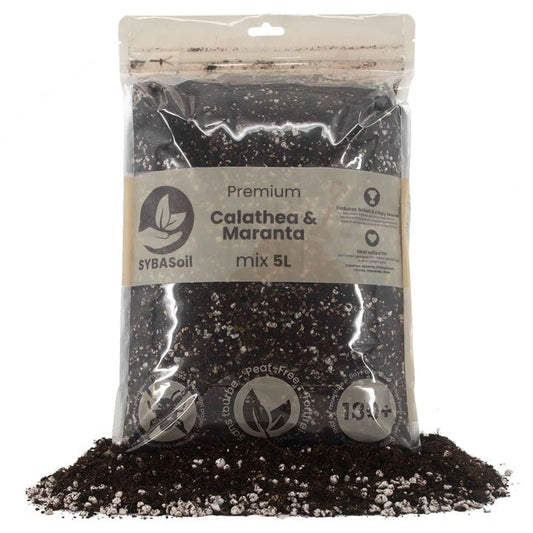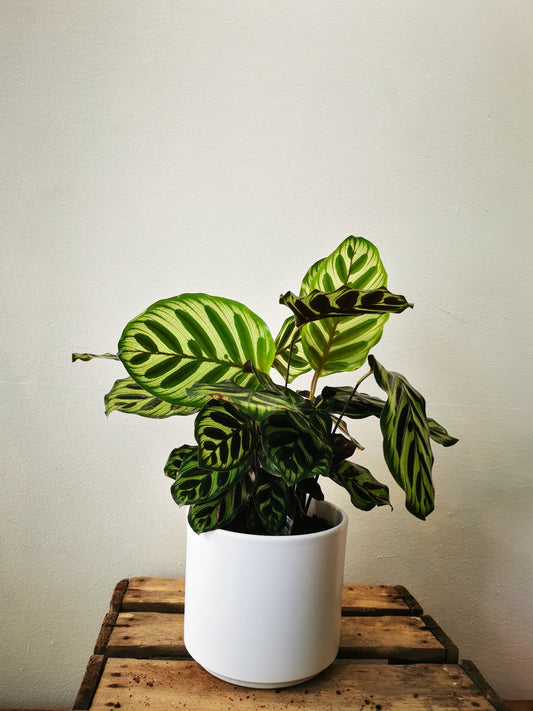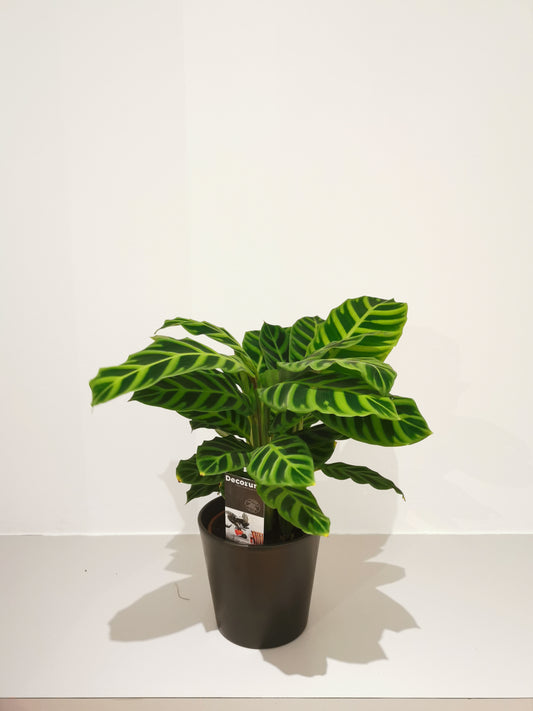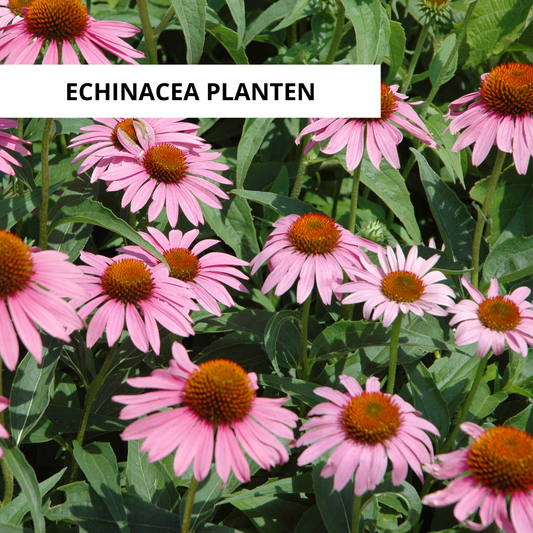
How to care for Calatheas
Share
Calatheas are beautiful, tropical plants that originally come from the jungle.

They are known for their striking, variegated leaves, which can be green, pink, purple or red. Calatheas are not easy to care for, but there are a few things you should keep in mind to keep them happy and healthy.
Watering is perhaps the most important aspect of calathea care. These plants like to be kept moist, but not soggy. Allow the top of the soil to dry out before watering your calathea again, and always allow the plant to drain.
As for light, Calathea do best in bright, indirect light. Too much sun will cause their leaves to bleach or burn, so always avoid direct sunlight.
Common problems with Calatheas include browning leaves, spider mites, and root rot. However, these problems can all be avoided with proper care. With a little love and attention, your Calathea will grow and bring beauty to your home for years to come.
In this blog you can read everything about the Calathea, in detail!
By the way, you can find all our Calatheas here: Our Calatheas
General information about the Calathea
The Calathea is a beautiful and popular houseplant, valued for its striking leaves. But where does this exotic plant come from? The Calathea originates from the tropical rain forests of South America. It grows under the canopy of taller trees, where it receives filtered light. This environment is also very humid, and therefore Calatheas need high humidity to thrive.
The Calathea has several close relatives, including the Maranta and the Ctenanthe. These plants are all members of the Marantaceae family, which is native to tropical regions around the world. So the next time you see a Calathea, take a moment to appreciate its unique origin story!

The different types of Calathea
These are the most common Calatheas , but there are more than this list contains.
- Calathea Makoyana
- Calathea Orbifolia
- Calathea Sanderiana/Ornata
- Catahea Rufibarba
- Calathea Triostar
- Calathea White fusion
- Calathea Yellow Fusion
- Calathea Zebrina
- Calathea White Star
- Calathea Tricolor
- Calathea Medallion
- Calathea Network
- Calathea Wavestar
- Calathea Warzewiscii
- Calathea Roseopicta
- Calathea Vilata
If you are looking for another type, you can always contact us. We can order almost any plant in the world from our specialized growers in Asia. You can contact us via email or social media or just drop by the store.
Calathea and sunlight
If you are looking for a plant that thrives in low light , the Calathea is a good option. This tropical plant originates from the rainforests of South America, where it grows under the canopy of taller trees. As a result, it is used to living in conditions with little direct sunlight.
If the Calathea is in a room that is too bright, the leaves will often turn pale or yellow. If this happens, you can move the plant to a spot with less light. In general, Calathea does best in indirect sunlight or in shady places . With its beautiful markings and reputation for being dramatically strong, Calathea is certainly a plant that requires some extra care. But if you are willing to make the effort, you will be rewarded with a beautiful addition to your home.
Watering the Calathea

Every plant lover knows that different plants have different watering needs. Some, like succulents, can survive on very little water, while others, like ferns, need to be kept moist at all times.
Calathea is a tropical plant that falls into the latter category. It is native to South America, prefers a warm, humid environment, and needs to be watered regularly to thrive. If the soil around a Calathea becomes too dry, the leaves will droop and turn brown. However, overwatering can also be harmful, leading to root rot and fungal problems.
As a general rule of thumb, it is best to water your Calathea when the top inch or two of soil is dry. By following these simple guidelines, you can keep your Calathea healthy and happy for years to come.
Common Calathea Problems
The leaves of my Calathea are turning yellow
If you have a Calathea, you may have noticed that the leaves are starting to turn yellow. This is a common problem that can be caused by a number of factors, including too little light, too much water, or even too much fertilizer. The good news is that it is relatively easy to fix.
First, check that your plant is getting enough sunlight. If it is in a low-light environment, try moving it to a slightly brighter spot. The more light it gets, the more water it will use.
Secondly, make sure you water your plant regularly and do not let the soil dry out. However, the Calathea does not like wet feet. If water remains in the decorative pot of the Calathea for a long time, root rot can occur. If you have this in mind, it is best to remove the rotten roots as soon as possible.
Thirdly, you need to be careful with fertilizer. Too much fertilizer can cause yellowing of the leaves, so limit the amount you use or switch to a different type. With a little care and attention, your Calathea plant will soon look as good as new. So don't give up!
A brown one edge on the leaf of my Calathea
If you have a Calathea plant, you may have noticed that the leaves are starting to turn brown at the edges. This is a common problem that can be caused by a number of factors, including too much sun, too little water, too little humidity, or even fluoride in the water. Fortunately, it is usually quite easy to fix.
Start by moving your plant to a spot with less direct sunlight. If you think your plant is getting too much water, don’t let the soil dry out completely between waterings. You may also want to switch to distilled water or rainwater, as fluoride can build up in tap water over time and cause brown leaf edges. In any case, it’s best to prune off any damaged leaves.
The roots of my Calathea are coming out from under the pot
Over time, even the most well-cared-for plants will outgrow their pots. When this happens, it’s time to repot your plant. Calatheas are particularly susceptible to potted vegetation, as they have a relatively fast growth rate. Repotting calatheas is a simple process, but there are a few things you should keep in mind to ensure that your plant thrives in its new home.
First, choose a pot that is only slightly larger than the current pot. Too large a pot will result in soft, spindly growth.
Second, use a light, well-draining potting soil. Calathea prefers slightly acidic soil, so consider adding some peat moss to the mix. Looking for potting soil for your Calathea?
Finally, after repotting, water the plant thoroughly and place it in a bright, but indirect, spot. With a little care, your Calathea will quickly adjust to its new home and continue to bloom.
Is the Calathea Poisonous?
The Calathea is not poisonous and therefore the perfect plant to put in a room with pets or small children. The plant is not tasty, but also not poisonous. Those who want to taste it can do so without any worries. (We are not responsible!)
Want to discover other non-toxic plants ?
Calatheas and pests
Calatheas are beautiful, low-maintenance houseplants that are perfect for adding a touch of green to any room. However, these popular plants can be susceptible to spider mites and other pests. These tiny creatures can wreak havoc on Calathea leaves, causing brown spots and curling leaves.
If you suspect your plant is infested, there are a few things you can do to get rid of the pests.
First, try spraying the plant with water to drive away the mites.
Second, increase the humidity around the plant by misting it regularly or placing it on a pebble tray.
Finally, consider using an organic insecticide to kill any remaining pests. With a little effort, you can get rid of spider mites and keep your Calathea plant healthy and beautiful.
A question that is not answered? Please contact us via email, social media, carrier pigeon, smoke signal or other forms.






